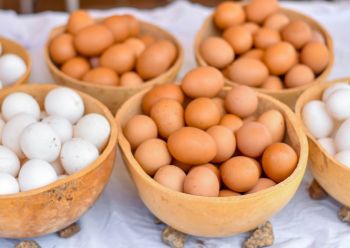Small-scale egg and orange-fleshed sweet potato production and utilisation in selected communities in Ghana: A mixed-methods study
Abstract
Background
Nutrition-related exposures during the first 1,000 days of life are a predictor of health outcomes later in life. World Vision Ghana’s ‘Improved Feeding practices for the 1,000 days’ (IFP) project aimed to improve dietary practices of women and children utilising an integrated intervention approach including nutrition, health, and agriculture strategies.
Objective
This paper reports on the production and utilisation of orange-fleshed sweet potatoes (OFSP) and eggs for improving diets of women in reproductive age and young children during the first 1,000 days of life.
Methods
Primary data from Kassena-Nankana West (KNW), Sekyere East (SE) and Kintampo South (KS) districts were triangulated with project routine data for this analysis. Univariate analyses of quantitative data from baseline and implementation monitoring data were conducted to describe the sociodemographic characteristics of beneficiaries, inputs disbursed, outputs produced, and utilisation of the food commodities. Qualitative interviews from 61 participants were transcribed, coded, and thematically analysed; these were triangulated with the quantitative data to capture main themes and findings.
Results
OFSP and egg production and consumption increased annually across beneficiary communities. In 2021, 100% of OFSP produced was consumed in KS; in SE, 95.0% was consumed and 5.0% lost to post-harvest losses. In 2022, 90% OFSP produced in KNW was consumed and 9.0% sold. In KS, 90.3% was consumed and 9.0% sold. In SE, 82.3% was consumed and 17.1% sold. Egg production at the end of the first production year (2022) was 18,720 crates in KNW, 19,680 crates in KS and 40,128 crates in SE. Egg consumption in sample households was less than 10% in 2022 and showed a decreased trend in the first half of 2023. In SE and KS, egg and OFSP production, respectively, increased, exponentially; sale for income was the most common mode of utilisation in eggs but OFSP was consumed in these districts. In KNW, climate, irrigation and socio-cultural barriers hindered the maximal production and utility of the produce, which was not observed in SE and KS, which did not have any of these identified barriers. Reported unintended benefits of production and utilisation included increased household income, food security, and availability of organic manure as a side-product of poultry.
Conclusions
The IFP project resulted in increased household level production, use and distribution of Eggs and OFSP across the three focal districts. Similar settings may benefit from this intervention by adapting the strategies to become easier for beneficiaries to better cope with likely potential barriers such as poultry mortality and water scarcity.

Authors retain all copyrights. In making a submission to World Nutrition, they are certifying that all material is theirs except quotations, as indicated, and that they have obtained permission for any photos, tables, or graphics taken from other publications or websites.




